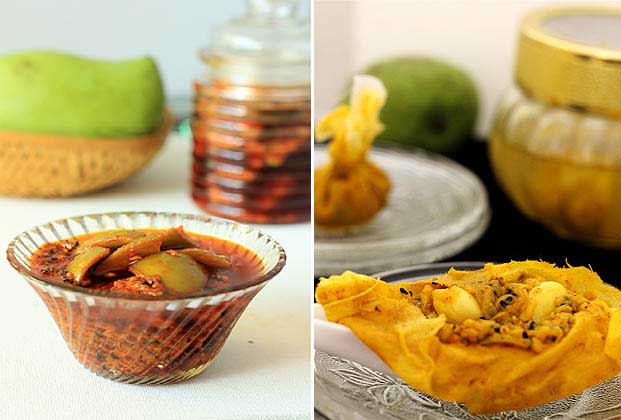5 Sindhi Pickles That You Must Make This Summer
- By Alka KeswaniLoading...
- | 21 April 2016 3:44 PM IST
 X
X
 Sindhi mango pickles. Photos: Alka Keswani
Sindhi mango pickles. Photos: Alka Keswani
Sindhis love papad and pickles. While the urad dal papad spiced up with asafoetida and black pepper is mandatory with every Sindhi meal, the pickles too hold the pride of place in the cuisine.
In India, summer is the season for pickles. It's a time when pickle-makers throng the markets as soon as the green, tart mangoes (also known as kairi/ ambhri) arrive. For Sindhis, it’s just the right time to stock jars with sour mango pickles and sweet preserves. Along with mango pickles, various vegetables pickled in lemon or lime juice are stocked up to relish in summer to pep up the sluggish appetite. Unlike everyday pickles that are infamous for high oil and sodium content, the Sindhi paariyan waari khatairn is a zero-oil pickle made with mustard seeds and water.
Here are some Sindhi pickles that you must make this summer to get your daily dose of probiotics.
Ambhryun ji khatairn (mango pickle): It is one of the most-loved mango pickle, and made from tender unripe mangoes. Small pieces of ambhri or kairi are pickled with roasted seeds of Nigella seeds, fenugreek, fennel, mustard etc along with salt and red chilli powder and covered with mustard oil. Unlike the store-brought mango pickles, this homemade Sindhi pickle is brownish in colour and not bright red. The mature pickle (at least a year old) is darker in colour, and has a very soft bite to it.
Beendi/ Potli/Ghathri pickle (grated mango pickle): Perhaps the most exotic of all the pickles, this unique mango pickle is made by mixing grated raw mangoes with spices like Nigella seeds, asafoetida, fenugreek seeds, fennel, black pepper corns, a little mustard oil etc and a spoonful of this mix, along with a clove of garlic placed on a piece of muslin cloth, and tied up so as to make a bouquet or potli of sorts. The mouth of the potlis are then tied with thread, and are immersed in a water-vinegar-mustard oil mix and left for fermentation. When each potli is untied, revealing a mushy, aromatic, bright sunny coloured mango pickle with a piece of garlic cozily tucked in, people around can’t wait to dig in!
 Pickles made with vegetables like carrots, onions & limes. Photos: Alka Keswani
Pickles made with vegetables like carrots, onions & limes. Photos: Alka Keswani
Paarinyah waari khatairn (paarin= water, khatairn= pickle): This zero-oil pickle is a variation of Kanji pickle, where instead of black carrots, vegetables like red onions, spring onions, carrots as well as turnips are mixed with coarse mustard seeds powder, water, salt and red chilli powder. The mixture is allowed to ferment for two to three days. The fermented water is often ladled over khichreen (kind of Indian risotto) and the bites of tangy, pickled vegetables provide the required oomph to the otherwise bland rice and lentil mixture. If available, fresh green garlic is added to the water pickle to add some punch. Shelf life of these kind of pickles is short though.
Leemun ain mirchan ji khatairn (lemon and green chilies pickle): Again a zero-oil pickle, perfectly suitable for the sultry weather, this one is made by pickling quarters of lemons/lime (kagazi limbu are preferred), ginger, cloves of garlic and green chilies (less hot, preferably Bhavnagri variety) in lemon juice and a salt base. This pickle too ferments quickly and is loved by elderly people.
Saandhyal Gajrun ji khatairn (carrot pickle): Another favourite of Sindhis, saandhyal gajrun ji khatairn is made by pickling sliced carrots in a mixture of pounded mustard seeds, salt, turmeric, red chilli powder and a little mustard oil to coat the carrots. The mixture is left to ferment for two to three days, and has a better shelf life than a water-based pickle.
ALSO WATCH: How To Make Home-Made Carrot Pickle



